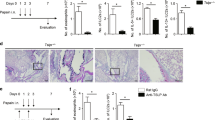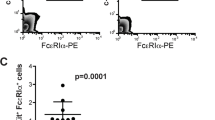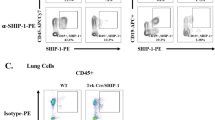Abstract
Severe asthma is associated with the production of interleukin 17A (IL-17A). The exact role of IL-17A in severe asthma and the factors that drive its production are unknown. Here we demonstrate that IL-17A mediated severe airway hyperresponsiveness (AHR) in susceptible strains of mice by enhancing IL-13-driven responses. Mechanistically, we demonstrate that IL-17A and AHR were regulated by allergen-driven production of anaphylatoxins, as mouse strains deficient in complement factor 5 (C5) or the complement receptor C5aR mounted robust IL-17A responses, whereas mice deficient in C3aR had fewer IL-17-producing helper T cells (TH17 cells) and less AHR after allergen challenge. The opposing effects of C3a and C5a were mediated through their reciprocal regulation of IL-23 production. These data demonstrate a critical role for complement-mediated regulation of the IL-23–TH17 axis in severe asthma.
This is a preview of subscription content, access via your institution
Access options
Subscribe to this journal
Receive 12 print issues and online access
$209.00 per year
only $17.42 per issue
Buy this article
- Purchase on Springer Link
- Instant access to full article PDF
Prices may be subject to local taxes which are calculated during checkout








Similar content being viewed by others
References
Al-Ramli, W. et al. T(H)17-associated cytokines (IL-17A and IL-17F) in severe asthma. J. Allergy Clin. Immunol. 123, 1185–1187 (2009).
Chakir, J. et al. Airway remodeling-associated mediators in moderate to severe asthma: effect of steroids on TGF-β, IL-11, IL-17, and type I and type III collagen expression. J. Allergy Clin. Immunol. 111, 1293–1298 (2003).
Barczyk, A., Pierzchala, W. & Sozanska, E. Interleukin-17 in sputum correlates with airway hyperresponsiveness to methacholine. Respir. Med. 97, 726–733 (2003).
He, R., Oyoshi, M.K., Jin, H. & Geha, R.S. Epicutaneous antigen exposure induces a Th17 response that drives airway inflammation after inhalation challenge. Proc. Natl. Acad. Sci. USA 104, 15817–15822 (2007).
Pichavant, M. et al. Ozone exposure in a mouse model induces airway hyperreactivity that requires the presence of natural killer T cells and IL-17. J. Exp. Med. 205, 385–393 (2008).
Schnyder-Candrian, S. et al. Interleukin-17 is a negative regulator of established allergic asthma. J. Exp. Med. 203, 2715–2725 (2006).
Lewkowich, I.P. et al. Allergen uptake, activation, and IL-23 production by pulmonary myeloid DCs drives airway hyperresponsiveness in asthma-susceptible mice. PLoS ONE 3, e3879 (2008).
Hellings, P.W. et al. Interleukin-17 orchestrates the granulocyte influx into airways after allergen inhalation in a mouse model of allergic asthma. Am. J. Respir. Cell Mol. Biol. 28, 42–50 (2003).
Grunig, G. et al. Requirement for IL-13 independently of IL-4 in experimental asthma. Science 282, 2261–2263 (1998).
Wills-Karp, M. et al. Interleukin-13: central mediator of allergic asthma. Science 282, 2258–2261 (1998).
Cortez, D.M. et al. IL-17 stimulates MMP-1 expression in primary human cardiac fibroblasts via p38 MAPK- and ERK1/2-dependent C/EBP-β, NF-κB, and AP-1 activation. Am. J. Physiol. Heart Circ. Physiol. 293, H3356–H3365 (2007).
Laan, M., Lotvall, J., Chung, K.F. & Linden, A. IL-17-induced cytokine release in human bronchial epithelial cells in vitro: role of mitogen-activated protein (MAP) kinases. Br. J. Pharmacol. 133, 200–206 (2001).
Poltorak, A. et al. Defective LPS signaling in C3H/HeJ and C57BL/10ScCr mice: mutations in Tlr4 gene. Science 282, 2085–2088 (1998).
Karp, C.L. et al. Identification of complement factor 5 as a susceptibility locus for experimental allergic asthma. Nat. Immunol. 1, 221–226 (2000).
Wetsel, R.A., Fleischer, D.T. & Haviland, D.L. Deficiency of the murine fifth complement component (C5). A 2-base pair gene deletion in a 5′-exon. J. Biol. Chem. 265, 2435–2440 (1990).
Zhang, X. et al. A protective role for C5a in the development of allergic asthma associated with altered levels of B7–H1 and B7-DC on plasmacytoid dendritic cells. J. Immunol. 182, 5123–5130 (2009).
Katz, Y., Nadiv, O., Rapoport, M.J. & Loos, M. IL-17 regulates gene expression and protein synthesis of the complement system, C3 and factor B, in skin fibroblasts. Clin. Exp. Immunol. 120, 22–29 (2000).
Frelin, C. et al. AS602868, a pharmacological inhibitor of IKK2, reveals the apoptotic potential of TNF-α in Jurkat leukemic cells. Oncogene 22, 8187–8194 (2003).
Weichhart, T. et al. The TSC-mTOR signaling pathway regulates the innate inflammatory response. Immunity 29, 565–577 (2008).
Wilson, R.H. et al. Allergic sensitization through the airway primes Th17-dependent neutrophilia and airway hyperresponsiveness. Am. J. Respir. Crit. Care Med. 180, 720–730 (2009).
Fahy, J.V., Kim, K.W., Liu, J. & Boushey, H.A. Prominent neutrophilic inflammation in sputum from subjects with asthma exacerbation. J. Allergy Clin. Immunol. 95, 843–852 (1995).
Ordonez, C.L., Shaughnessy, T.E., Matthay, M.A. & Fahy, J.V. Increased neutrophil numbers and IL-8 levels in airway secretions in acute severe asthma: Clinical and biologic significance. Am. J. Respir. Crit. Care Med. 161, 1185–1190 (2000).
Shannon, J. et al. Differences in airway cytokine profile in severe asthma compared to moderate asthma. Chest 133, 420–426 (2008).
Newcomb, D.C. et al. A functional IL-13 receptor is expressed on polarized murine CD4+ Th17 cells and IL-13 signaling attenuates Th17 cytokine production. J. Immunol. 182, 5317–5321 (2009).
Harrington, L.E. et al. Interleukin 17-producing CD4+ effector T cells develop via a lineage distinct from the T helper type 1 and 2 lineages. Nat. Immunol. 6, 1123–1132 (2005).
Huang, F. et al. Potentiation of IL-19 expression in airway epithelia by IL-17A and IL-4/IL-13: important implications in asthma. J. Allergy Clin. Immunol. 121, 1415–1421 (2008).
Wakashin, H. et al. IL-23 and Th17 cells enhance Th2-cell-mediated eosinophilic airway inflammation in mice. Am. J. Respir. Crit. Care Med. 178, 1023–1032 (2008).
Kohl, J. et al. A regulatory role for the C5a anaphylatoxin in type 2 immunity in asthma. J. Clin. Invest. 116, 783–796 (2006).
Drouin, S.M., Sinha, M., Sfyroera, G., Lambris, J.D. & Wetsel, R.A. A protective role for the fifth complement component (c5) in allergic airway disease. Am. J. Respir. Crit. Care Med. 173, 852–857 (2006).
Braun, M.C., Lahey, E. & Kelsall, B.L. Selective suppression of IL-12 production by chemoattractants. J. Immunol. 164, 3009–3017 (2000).
Hawlisch, H. et al. C5a negatively regulates toll-like receptor 4-induced immune responses. Immunity 22, 415–426 (2005).
Bautsch, W. et al. Cutting edge: guinea pigs with a natural C3a-receptor defect exhibit decreased bronchoconstriction in allergic airway disease: evidence for an involvement of the C3a anaphylatoxin in the pathogenesis of asthma. J. Immunol. 165, 5401–5405 (2000).
Humbles, A.A. et al. A role for the C3a anaphylatoxin receptor in the effector phase of asthma. Nature 406, 998–1001 (2000).
Koren, H.S. et al. Ozone-induced inflammation in the lower airways of human subjects. Am. Rev. Respir. Dis. 139, 407–415 (1989).
Polack, F.P. et al. A role for immune complexes in enhanced respiratory syncytial virus disease. J. Exp. Med. 196, 859–865 (2002).
Walters, D.M., Breysse, P.N., Schofield, B. & Wills-Karp, M. Complement factor 3 mediates particulate matter-induced airway hyperresponsiveness. Am. J. Respir. Cell Mol. Biol. 27, 413–418 (2002).
Nakano, Y. et al. Elevated complement C3a in plasma from patients with severe acute asthma. J. Allergy Clin. Immunol. 112, 525–530 (2003).
Barnes, K.C. et al. Variants in the gene encoding C3 are associated with asthma and related phenotypes among African Caribbean families. Genes Immun. 7, 27–35 (2006).
Hasegawa, K. et al. Variations in the C3, C3a receptor, and C5 genes affect susceptibility to bronchial asthma. Hum. Genet. 115, 295–301 (2004).
Trompette, A. et al. Allergenicity resulting from functional mimicry of a Toll-like receptor complex protein. Nature 457, 585–588 (2009).
Hammad, H. et al. House dust mite allergen induces asthma via Toll-like receptor 4 triggering of airway structural cells. Nat. Med. 15, 410–416 (2009).
Kurreeman, F.A. et al. The TRAF1–C5 region on chromosome 9q33 is associated with multiple autoimmune diseases. Ann. Rheum. Dis. 69, 696–699 (2009).
Pernis, A.B. Th17 cells in rheumatoid arthritis and systemic lupus erythematosus. J. Intern. Med. 265, 644–652 (2009).
Hofstetter, H., Gold, R. & Hartung, H.P. Th17 Cells in MS and Experimental Autoimmune Encephalomyelitis. Int. MS J. 16, 12–18 (2009).
Emamaullee, J.A. et al. Inhibition of Th17 cells regulates autoimmune diabetes in NOD mice. Diabetes 58, 1302–1311 (2009).
Krutzik, P.O., Irish, J.M., Nolan, G.P. & Perez, O.D. Analysis of protein phosphorylation and cellular signaling events by flow cytometry: techniques and clinical applications. Clin. Immunol. 110, 206–221 (2004).
Schulz, K.R., Danna, E.A., Krutzik, P.O. & Nolan, G.P. Curr. Protoc. Immunol. (ed. Coico, R.) Ch. 8 Unit 8, 17 (John Wiley & Sons, Somerset, New Jersey, 2007).
Acknowledgements
We thank C. Gerard (Harvard University) for C3ar1-deficient and C5ar1-deficient mice; F. Finkelman (Cincinnati Children's Hospital Medical Center) for IgG2a (GL117); M. Adcock (Imperial College London) for AS602868; and C. Karp for discussions. Supported by the US National Institutes of Health (HL67736, AI083315, U19A1070235 and P50ES015903 to M.W.-K., and AR47363 to the flow cytometry core of Cincinnati Children's Hospital Medical Center) and the Parker B. Francis Fellowship Program (I.P.L.).
Author information
Authors and Affiliations
Contributions
S.L. and I.P.L. initiated, designed and did experiments, analyzed data and wrote the manuscript; K.D., A.A.S., J.R.C. and Y.S. did experiments; A.L.B. provided critical materials; and M.W.-K. directed the research, designed experiments and wrote the manuscript.
Corresponding author
Ethics declarations
Competing interests
A.L.B. is an employee of Amgen.
Supplementary information
Supplementary Text and Figures
Supplementary Figures 1–6 and Supplementary Table 1 (PDF 2368 kb)
Rights and permissions
About this article
Cite this article
Lajoie, S., Lewkowich, I., Suzuki, Y. et al. Complement-mediated regulation of the IL-17A axis is a central genetic determinant of the severity of experimental allergic asthma. Nat Immunol 11, 928–935 (2010). https://doi.org/10.1038/ni.1926
Received:
Accepted:
Published:
Issue Date:
DOI: https://doi.org/10.1038/ni.1926
This article is cited by
-
Psoriasis associated with asthma and allergic rhinitis: a US-based cross-sectional study using the All of US Research Program
Archives of Dermatological Research (2023)
-
Inulin fibre promotes microbiota-derived bile acids and type 2 inflammation
Nature (2022)
-
IL-17A both initiates, via IFNγ suppression, and limits the pulmonary type-2 immune response to nematode infection
Mucosal Immunology (2020)
-
New insights into the immune functions of complement
Nature Reviews Immunology (2019)
-
Human iPSC-MSCs prevent steroid-resistant neutrophilic airway inflammation via modulating Th17 phenotypes
Stem Cell Research & Therapy (2018)



